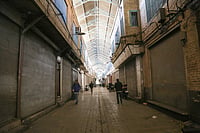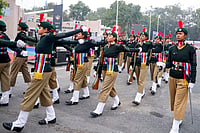But who put them in?
At its peak, the 78-year-old institution, spun off from AT&T in 1925, counted in its ranks nearly 30,000 scientists and researchers in 25 countries across the world, most of them at its Murray Hill headquarters in New Jersey. With a $4 billion budget, it was the largest R&D organisation in the world dedicated to communications research. Even today, pared down to around 10,000 heads (and what heads they are!) following the tech meltdown, it is still home to one of the largest pools of scientific manpower in the world. They come from all over the world, the Americas, Europe, China, Japan, Middle East, Central Asia, Far East, Australia, you name it. According to one count, more than 50 per cent of Bell Labs researchers are of non-American origin. But the single biggest brigade, Americans aside, come from—how did you guess?—India.
Just how many Indians work or have worked at Bell Labs is a matter of guesstimation because the institute does not keep an ethnic headcount. Some say, at its peak, it may have been up to 15 per cent of researchers, perhaps even 20 per cent, especially in some units of fundamental science. Others maintain it has averaged 10 per cent over the years. In any event, there are certainly thousands of them. "Without making a to-do about ethnicity, and remembering Bell has an incredibly multicultural environment, let’s say it’s a big number and some of our brightest people are from India," says Saswato Das, the Lab’s communications manager.
Scientists of Indian origin have always been a big presence in labs and universities in the US and 5 to 10 per cent is a good estimate for any decent research facility or university now. From mit to Stanford, you see and hear them winning laurels all the time. More recently, they have moved into the upper echelons of sci-tech management, as the early birds who came here in the 1960s and 1970s reach the pinnacle of their career. Early this year, Dr Praveen Chaudhuri, a long-time associate at IBM Research (another desi haunt, which, along with nasa, deserves a separate look) was appointed head of Brookhaven National Laboratory, a 3,000-strong, $500-million research facility. Indians also occupy top departmental positions at labs like Oakridge, Sandia, Lawrence Livermore and the National Institute of Health.

But of all the institutions, Bell Labs has been the cosiest desi adda outside India. "You take away Indians from US research and academia, especially here at Bell, and there will be a big vacuum," says Lov Grover, Bell’s famed number cruncher who the scientific cognoscenti feel may well be a Nobel Laureate some day.
The acme of Indian achievement in the sci-tech leadership came in October 1999 when Arun Netravali, 53, a genial techie from Mumbai (IIT, where else?) and a native of Karnataka’s North Kanara district, became Bell Labs’ ninth president, the first non-white in its 75-year history. As executive vice president of research at Bell, Netravali had overseen the world’s first long-distance transmission of a terabit (a trillion bits) of information per second over a single strand of optical fiber and a major semiconductor breakthrough in the form of the world’s smallest working transistor, not to speak of his own contributions to the arrival of the High-Definition Television (HDTV). "Bell Labs is a powerhouse of innovation. The collective brainpower here is awe-inspiring," Netravali said then on taking over. "It will be an honour to support the scientists and engineers here, many of whom are recognised gurus in their fields."
Netravali’s use of the word "gurus" was perhaps not an accident. While his elevation emphasised the arrival of Indians on the top tier of science management, long before this promotion, desis blazed an early trail at Bell. You can see this in the Bell Labs museum on the first floor of the main building, a rather modest block redolent of some Indian public sector company with none of the architectural pizzazz of the modern facilities of North Carolina’s Research Triangle or Boston’s Route 128. Here, in a glass-enclosed exhibition, Bell showcases some of its greatest inventions—the first transistor, the first solar cell, the first laser, the first fax, the first communication satellite and sundry gee-gaws that are so commonplace now. But from the time they were invented or devised at Bell, they profoundly changed the way we live and work. And many of these works are credited to Indian gurus.
One such invention involves Mohan Sondhi, whose 35-year career at Bell Labs yielded such breakthroughs as the echo canceller (the reason why you hear such clear communications today as compared to the 1960s) and work in speech recognition patterns. Then you see the work of Bishnu Atal, whose digital speech coding innovations dramatically expanded the benefits of cellular phone technology. Then of course there is Arun Netravali, Bell’s most famous Indian Hall of Famer by virtue of his top dog status, whose pioneering contributions transformed TV from analog to digital and ushered in HDTV. Among the first Indians at Bell who rose to one of the highest ranks was C. Kumar N. Patel, who hails from a place in Maharashtra better known to political junkies as the hometown of Sharad Pawar—Baramati. In 1964, Patel invented the carbon dioxide laser, which today is said to have more practical application than any other laser. It is used in industry, medicine, environmental sciences and even has military applications (most notably in Ronald Reagan’s Star Wars system). So profound and sweeping was his work and vision that in the early 1980s, Patel was appointed Director of AT&T Bell Labs’ Electronics Research Lab, a position he held till the early 1990s when the University of California at Los Angeles (UCLA) wooed him away to be its Vice Chancellor for Research. It was not until a decade later that another Indian at Bell—Arun Netravali—would eclipse him.

By the 1980s, Bell Labs was getting increasingly ‘desified.’ Bharat Doshi, who now heads the Performance Analysis Department in the Advanced Communications Technologies Center at Bell Labs, remembers well how it all started to happen. When he joined Bell in 1979 after receiving his PhD from Cornell, there were fewer than a hundred Indians, he says. But within a few years, Doshi found himself increasingly collaborating with fellow Indians, as they came in droves. Engineering the world’s move from analog to digital communications, Doshi was working with Anil Sawkar and Sanjiv Nanda on Voice over ATM; with Subra Dravida and K. Sriram on Voice over Internet; with P. Harshavardhan on optical network restoration. Their work, most of which is now industry standard, is the reason why systems don’t break down when there are 50 million calls during a calamity or why you can talk on the cheap from an Internet cafe. "I used to boast that because we did so well, they began hiring more and more Indians," kids Doshi. "At one time, I would think at least 20 per cent of the research staff in some of the departments were of Indian origin." Doshi exemplifies the patented Indian techie model that Americans are increasingly familiar with. And it is recorded in a very unique way at the Bell Museum, where a live electronic meter ticks over the number of patents Bell researchers have scored over the years (it’s now an average of two every day; the day I visited, it was showing 31,067). In March this year, Doshi, along with three of his colleagues, recorded the 30,000th patent that Bell has received since its inception in 1925—listed rather more mundanely at the US Patent Office (USPO) as patent No. 6,529,499. The landmark 30K Bell number was for their work covering the mechanisms for guaranteeing application Quality of Service (QoS) in Internet Protocol (IP) networks—or simply put, to improve the way you can talk on the internet.
While Doshi is a long server at Bell, the great institution, which some feel is in decline because of the tech meltdown, has seen hundreds of Indians pass through its august labs. Some, like Dr Anant Dodabalapur, who now heads the Microelectronics Research Center at the University of Texas in Austin, and Dr Venki Narayanamurthi, Dean of Engineering and Applied Sciences at Harvard, returned to academia. Others, like Washington area entrepreneur Hemant Kanakia (Torrent Technologies, which he sold to Ericcson for $400 million) and Rajiv Laroia (Founder and CTO of Flarion) left to do their own start-ups, often under the aegis of Bell or sibling Lucent. In fact, the list of Bell Indians who have founded their own companies would require a separate story.
Some have also gone back to India, as in the case of one of Bell’s most famous desi sons who returned to TIFR. Narendra Karmakar worked at Bell in the ’80s and was responsible for an innovation that led to one of the most widely debated patents in US history. In ’88, the USPO awarded Patent No. 4,744,028 to Karmakar for the solution to a mathematical wrangle, the linear programming problem with large numbers of activities: basically crunching data with a huge number of variables. Till the USPO awarded a patent to the Karmakar Algorithm (algorithms are sets of instructions that allow computers to perform specific tasks), it was generally assumed that equations are simply laws of nature and not patentable. But since Karmakar’s solution was unique and had commercial applications, the USPO okayed the patent. Even now, Karmakar’s algorithm is applied in the airline industry for assigning routes and flights, or as Dr Debashish Mitra, now Director of Bell’s Math Lab, jokes, "It’s the reason why airline scheduling and fares are so confusing."

Dr Mitra himself is one of Bell’s golden oldies. Moving to the US from London University in 1968, Mitra chose Bell over offers from mit and Harvard because it had an even greater reputation than the great universities. His contributions to digital signal processing and adaptive echo cancellation (on which he worked with Mohan Sondhi) are considered central to the development of technology introduced in the 1970s to enhance voice quality. Mitra’s Math Center now addresses critical issues in broadband, multimedia communications on next-generation networks, and is widely recognised to be one of the top groups in the world involved with networking fundamentals. "Bell remains one of the great research institutions despite its sizing down," says Mitra, who retains his Indian affections despite leaving the country for the UK as a teenager. "And it wouldn’t be the same without the Indians."
Bell Indians are almost as clubby as IITians (indeed many of them, like Netravali and Dodabalapur, are IITians.) "You see them everywhere in the world, in some of the finest institutions," says Dr Om Nalamasu, who was at Bell from 1982 till late last year when he left to become Director of the Center for Integrated Electronics at Rensselaer Polytechnic Institute (RPI) in upstate New York, the oldest engineering college in America, where, he says, the architecture spans three centuries (Aside: India’s oldest engineering school can also boast that: REC—now IIT—Roorkee, was founded in 1848). Not surprisingly, Nalamasu’s predecessor at rpi was Shyam Murarka, another Indian Bellwalla.
The Bell echo never goes away, concurs Dr Dodabalapur (whose last name takes after a taluka outside Bangalore where the village Rajghatta, after which this correspondent takes his last name, is located). Dodabalapur came to Bell in 1990 after a PhD from UT Austin. During his decade at Bell, he pioneered work on organic and polymer semiconductor devices which could dramatically change the economics of circuitry. The work was cited as one of the top 10 scientific breakthroughs for 2000 by Science magazine. BusinessWeek, in a 1999 story on Bell as an "ivory tower that spins pure gold", listed it among the Labs’ 20 leading inventions.
Over the last couple of years though, the Bell boys have been brought down from their ivory tower. Amid a searing meltdown in the communications industry, Bell sibling Lucent Technology has downsized from more than 1,25,000 employees to about 40,000, through retirement, attrition, and spinning off new companies like Agere and Avaya. Bell itself has lost more than half of its researchers, as it consolidated its work in more commercially viable areas. But it is still the fount of some of the most original and fundamental work in science, housing some of the most far-sighted thinkers and researchers.
One such Bell treasure is Lov Grover, inventor of some of the most versatile algorithms in quantum computing, a burgeoning field of research that applies concepts of quantum physics to building more efficient computers. Five years ago, Grover came up with an extremely fast algorithm—now called GSA or Grover Search Algorithm—that can identify an object in a large database even when the inquiry is somewhat vague or incomplete. For example, it could be used to hunt quickly for the exact name and telephone number of a person one has met briefly but whose name one has half-forgotten. Typically, if a database contains a million items, a classical computer typically requires 5,00,000 steps to find the correct item. Using the GSA, a quantum computer (of which only rudimentary versions have been built) can do it in about 1,000 steps—a remarkable improvement in speed that becomes more and more dramatic as the size of the database increases.

Another brilliant Indian head on the Murray Hill campus is Partha Mitra, described by his American colleagues as "one of the brightest stars in the brilliant galaxy of minds at Bell Labs". A physicist, mathematician and biologist rolled into one, his work spans a staggering range of issues, from groundbreaking contributions in optical and wireless communication, speech recognition, signal processing, to neural biology—the study of the brain. A recent company profile of this boyish wonder was headlined "A Beautiful Bell Labs Mind."
So how does all this benefit India? For the desi Bellwallas, knowledge knows no geographic boundaries. With collapsing distances and breakdown in communication barriers (instead of a communication breakdown), more and more Indians are to-ing and fro-ing from Bell. Like Karmakar, several highly rated Bell folk, such as physicist Pinaki Mazumder and network geek Anurag Kumar, have returned to India (to the Harish-Chandra Institute and the Indian Institute of Science respectively).
Today there actually appears to be a return movement from Bell and other institutions to India as market conditions continue to be tight in the US. Later this month, four members of Bharat Doshi’s team, Sarang Gadgil, Arnab Das, Chetan Vinchhi and Rudra Kumar Shivalingaiah will be relocating to India to work at Lucent Technologies’ Bangalore facility. "Except maybe in some area of encryption, I see no barriers to knowledge transfer," says Doshi. Besides, if there is one place Bell Labs can be replicated now, it is in India. Judging by the speed with which General Electric’s Jack Welch Research Center and IBM are ramping up in Bangalore, it should not—to paraphrase a popular Indian ad—take long, very long, ding dong.
(Chidanand Rajghatta is the US-based foreign editor of The Times of India, and author of The Horse That Flew: How India’s Silicon Gurus Spread Their Wings (HarperCollins India, 2001). His forthcoming book, The ABCD Chronicles, a study of India’s intellectual treasure trove outside its shores, is due early 2004.)


























